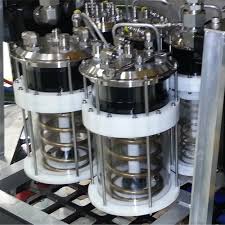Pressure Compensators
Pressure compensators are used in all subsea hydraulic systems to negate the effects of pressure differential at depth. The compensation maintains a constant slightly higher oil pressure within the hydraulic system, regardless of depth. It also provides the initial head pressure the hydraulic pump requires for startup without cavitation. Typically around 12 PSI. The design of the compensator ensures this slight over-pressure is maintained for all water depths, from surface to full ocean depth.
Compensators are also used on electrical enclosures to prevent collapse at depth. The enclosure is oil-filled & all air is bled from the system. The compensator is attached to automatically maintain a constant, slight over-pressure, regardless of depth. Typically 5PSI, 10PSI or 15 PSI.
As the internal oil is for all intents & purposes incompressible, this removes the external pressure differential when the enclosure is submerged and prevents enclosure collapse. This method allows lighter, thin wall enclosures to be used, as opposed to heavy thick walled pressure resistant enclosures, thus reducing the overall weight of the equipment.
Also by utilizing a slight over-pressure, this ensures that in the event of a leak, oil will leak out of the system before water is drawn in. Integral measurement transducers, built in to the compensator unit, monitor stroke (leakage) and give for-warning of any problems to the equipment operator, allowing for a timely recovery of the equipment before major damage occurs.

It is essential that all air in the compensation be removed prior to submersion. Any trapped air will be compressed at depth, causing the compensator to ‘stroke’ even though there is no leak. Resulting in less operating volume available for operation. This becomes very evident upon launch, as the measurement transducer will indicate the decreasing level & loss of available volume as depth increases. Typically combined bleed / relief valves are fitted to the compensator at the highest point in the system to protect the system from over-pressure and to facilitate air bleeding.
The transducers can be simple magnetically operated Hall Effect switches set to activate at 3 preset levels, or can be a Linear Hall Effect transducer providing a linear volume level measurement from 0% to 100%. The output of the transducer can be utilized by the equipment’s control system, which can in turn be configured to set alarms at preset (stroke) levels.
